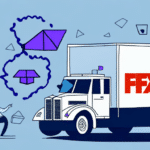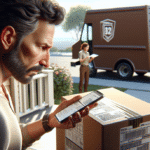Common Reasons for Failed UPS Deliveries
Experiencing a failed UPS delivery can be frustrating. Understanding the common reasons behind these issues can help you take proactive steps to ensure successful delivery. The most frequent causes include:
- Incorrect Address or Missing Information: A typo or incomplete address can prevent UPS from locating your delivery point. Always double-check your address details when placing an order.
- Unsuccessful Delivery Attempts: If you're unavailable during the delivery window, UPS may attempt to redeliver. Multiple unsuccessful attempts can lead to the package being returned to the sender.
- Weather Delays: Severe weather conditions such as heavy snow, flooding, or hurricanes can disrupt delivery schedules.
- Missing or Damaged Package: Although rare, packages can sometimes be lost or damaged during transit, hindering successful delivery.
- Customs Issues: For international shipments, delays in customs clearance can postpone delivery or result in the package being sent back.
Addressing these factors proactively can significantly reduce the chances of experiencing delivery issues.
Understanding the UPS Delivery Process
Having a clear understanding of how UPS processes deliveries can enhance your ability to track and manage your shipments effectively. The UPS delivery process involves several key steps:
- Package Pickup: UPS collects the package from the sender’s location.
- Sorting and Processing: The package is transported to a UPS facility where it is sorted and processed for its next destination.
- Transportation: The package is loaded onto a delivery vehicle and transported to the destination area.
- Final Delivery: The package is delivered to the recipient’s address.
UPS offers a variety of delivery options, including same-day, next-day, and ground delivery services, allowing customers to choose the option that best fits their needs. Additionally, UPS provides comprehensive tracking tools that enable you to monitor your package’s journey in real-time.
For more detailed information on the UPS delivery process, refer to the UPS Technology and Tracking Resources.
Effective Tracking Techniques for UPS Packages
Utilizing UPS’s tracking system efficiently can help you stay informed about your package’s status and avoid potential delivery issues. Here are some tips and tricks to enhance your tracking experience:
- Regularly Check Tracking Information: Monitoring your package's tracking updates can provide insights into its current status and any potential delays.
- Sign Up for Notifications: UPS offers email and text notifications to keep you updated on your package’s progress and any changes to the delivery schedule.
- Customize Tracking Preferences: Tailoring your tracking settings to receive specific updates, such as when the package is out for delivery or has been delivered, can help you stay informed without being overwhelmed by notifications.
- Utilize UPS My Choice: This service allows you to manage your deliveries more effectively by providing delivery alerts, the ability to reroute packages, and schedule delivery times that are convenient for you.
Leveraging these tracking techniques can significantly improve your ability to receive packages promptly and address any issues as they arise.
Steps to Take When Your UPS Package Goes Missing
If your UPS package hasn't arrived as expected, taking immediate action can help resolve the issue quickly. Follow these steps to locate your missing package:
- Verify Tracking Information: Start by reviewing the latest tracking updates to identify where the package may be or if there have been any reported delays.
- Contact the Sender: Reach out to the sender for additional information or to confirm that the package was dispatched correctly. The sender can also initiate a claim with UPS if necessary.
- Reach Out to UPS: Contact UPS customer service to report the missing package. Provide them with your tracking number and any relevant details to facilitate the search process.
- Check with Neighbors or Building Management: Sometimes, packages may be delivered to nearby addresses by mistake. Inquire with your neighbors or building management to ensure the package wasn't left elsewhere.
- Review Security Footage: If you have security cameras or a doorbell camera, check the footage to see if the package was delivered or if any suspicious activity occurred during delivery.
Following these steps promptly can increase the chances of recovering your missing package and minimizing any inconvenience.
Best Practices to Avoid UPS Delivery Issues
Implementing best practices can significantly reduce the likelihood of experiencing delivery problems with UPS. Consider the following strategies:
- Accurate Address Information: Ensure that your shipping address is correct and complete, including any apartment or suite numbers, to prevent delivery mishaps.
- Select Appropriate Delivery Options: Choose a delivery service that aligns with your schedule and the urgency of the package, such as UPS Next Day Air for time-sensitive deliveries.
- Provide Clear Delivery Instructions: Offering specific instructions, like a preferred entrance or gate code, can help UPS drivers locate your address more easily.
- Be Available for Delivery: Whenever possible, ensure that you or someone you trust is available to receive the package during the delivery window.
- Use Secure Delivery Locations: Consider using UPS Access Point locations or secure lockers for deliveries, especially if you’re not available to receive packages personally.
Adhering to these best practices can enhance the reliability of your UPS deliveries and minimize potential issues.
External Factors Affecting UPS Deliveries
Several external factors can influence the efficiency and success of UPS deliveries. Understanding these can help you anticipate and mitigate potential delays:
Weather Conditions
Adverse weather, such as snowstorms, heavy rain, or extreme temperatures, can disrupt transportation routes and delay deliveries. For instance, the National Hurricane Center reports that hurricanes can severely impact logistics, causing widespread delivery delays.
Holiday Seasons
During peak holiday periods, the volume of packages increases significantly, leading to longer delivery times and higher chances of delays. According to the UPS Press Room, holiday seasons can see a spike in shipment volumes by up to 30%, necessitating early shipping to ensure timely deliveries.
International Customs
For international shipments, customs clearance can be a significant hurdle. Delays in processing or unexpected customs regulations can postpone deliveries. To navigate customs efficiently, provide accurate documentation and consider using reputable customs brokers.
Technological Issues
Technical glitches in sorting systems or tracking technologies can lead to misrouted packages or inaccurate tracking information. UPS continuously invests in technology to minimize such issues, but occasional disruptions may still occur.
Being aware of these factors allows you to plan accordingly and take necessary precautions to ensure your packages arrive on time.
Future Trends and Innovations in UPS Delivery
The logistics industry is continually evolving, with UPS at the forefront of adopting new technologies and innovative practices to enhance delivery efficiency. Here are some emerging trends to watch:
- Drone Deliveries: UPS is exploring the use of drones for delivering packages in remote or congested areas. This technology promises faster delivery times and reduced operational costs.
- Electric and Autonomous Vehicles: To promote sustainability and efficiency, UPS is investing in electric delivery vehicles and autonomous technologies, which can reduce carbon emissions and optimize delivery routes.
- Smart Lockers and Pickup Points: Expanding the network of secure pickup locations offers greater flexibility for customers to retrieve packages at their convenience, reducing missed delivery attempts.
- Enhanced Data Analytics: Leveraging big data and AI, UPS aims to predict delivery patterns, optimize routes, and improve overall service reliability.
- Personalized Delivery Options: Offering more tailored delivery choices, such as specific delivery windows or in-home delivery, caters to individual customer preferences and improves satisfaction.
These advancements indicate a future where package delivery becomes faster, more efficient, and more environmentally friendly, benefiting both UPS and its customers.
Conclusion
Ensuring successful UPS deliveries involves understanding the delivery process, utilizing effective tracking methods, and adhering to best practices to avoid common issues. By staying informed about external factors and future innovations, you can better navigate the logistics landscape and enhance your overall delivery experience. For more tips and detailed guidance, refer to reputable sources such as the UPS Help Center and industry publications.






















